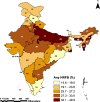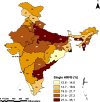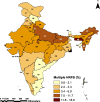Trends, patterns and predictors of high-risk fertility behaviour among Indian women: evidence from National Family Health Survey
- PMID: 38413929
- PMCID: PMC10900591
- DOI: 10.1186/s12889-024-18046-3
Trends, patterns and predictors of high-risk fertility behaviour among Indian women: evidence from National Family Health Survey
Abstract
Background: Numerous studies have demonstrated that high-risk fertility behaviour (HRFB), which includes maternal age below 18 or above 34 years, short birth intervals (less than 24 months), and high parity (birth order above 4), is associated with adverse maternal and child health outcomes. There is a substantial research gap in the domain of high-risk fertility behaviour in the Indian context. Therefore, this study is designed to investigate the current trends and patterns in the prevalence of high-risk births among Indian women, with a primary focus on identifying contributing factors associated with this prevalence.
Methods: The study utilized data from the nationally representative National Family Health Survey (NFHS), which has been conducted in five rounds since 1992-93. Data from all rounds were used to assess the overall trend. However, data from the most recent round of NFHS, conducted during 2019-21, were employed to evaluate current levels and patterns of HRFB prevalence and to identify socio-economic and demographic predictors of HRFB using binomial and multinomial logistic regression models.
Results: The prevalence of HRFB has exhibited a consistent decreasing pattern from 1992 to 93 to 2019-21 in India. However, 29.56% of married women continue to experience high-risk births with notably higher rates in several states (e.g., 49.85% in Meghalaya and 46.41% in Bihar). Furthermore, socio-demographic factors like wealth index, educational level, social group, religion, mass media exposure, family size, age at marriage, type and region of residence, and reproductive factors like birth intention, place and type of delivery, ANC visits and current contraceptive use were identified as significant predictors of high-risk births among women in India.
Conclusion: Despite a 20.4 percentage point decline in HRFB prevalence over the past three decades, a significant proportion of women in specific regions and demographic subgroups continue to experience high-risk births. Therefore, the present study recommends interventions aimed at preventing high-risk births among women in India, with particular emphasis on states with high HRFB prevalence and women from socioeconomically disadvantaged backgrounds.
Keywords: HRFB; India; Multinomial logistic regression; NFHS; Reproductive health.
© 2024. The Author(s).
Conflict of interest statement
The authors declare no competing interests.
Figures




Similar articles
-
Individual, household, and community-level factors associated with high-risk fertility behaviour among Nigerian women: secondary analysis of the 2018 demographic and health survey data.Reprod Health. 2025 Feb 3;22(1):17. doi: 10.1186/s12978-025-01956-9. Reprod Health. 2025. PMID: 39901270 Free PMC article.
-
Prevalence of anaemia among married women with recent birth history and high-risk fertility behaviour: secondary data analysis of the National Family Health Survey-India (2019-21).BMJ Open. 2024 Jan 31;14(1):e073395. doi: 10.1136/bmjopen-2023-073395. BMJ Open. 2024. PMID: 38296277 Free PMC article.
-
Determinants associated with high-risk fertility behaviours among reproductive aged women in Bangladesh: a cross-sectional study.Reprod Health. 2022 Jan 21;19(1):17. doi: 10.1186/s12978-022-01333-w. Reprod Health. 2022. PMID: 35062956 Free PMC article.
-
Understanding U.S. fertility: continuity and change in the National Survey of Family Growth, 1988-1995.Fam Plann Perspect. 1996 Jan-Feb;28(1):4-12. Fam Plann Perspect. 1996. PMID: 8822409 Review.
-
Fertility and family planning in the United States: insights from the National Survey of Family Growth.Fam Plann Perspect. 1988 Sep-Oct;20(5):207-17. Fam Plann Perspect. 1988. PMID: 3068068 Review.
Cited by
-
Individual, household, and community-level factors associated with high-risk fertility behaviour among Nigerian women: secondary analysis of the 2018 demographic and health survey data.Reprod Health. 2025 Feb 3;22(1):17. doi: 10.1186/s12978-025-01956-9. Reprod Health. 2025. PMID: 39901270 Free PMC article.
-
Unraveling the complexity of selected adverse neonatal outcomes in India: a multilevel analysis using data from a nationally representative sample survey.BMC Pregnancy Childbirth. 2025 Mar 31;25(1):377. doi: 10.1186/s12884-025-07448-9. BMC Pregnancy Childbirth. 2025. PMID: 40165129 Free PMC article.
References
-
- World Health Organization. (2019). Trends in maternal mortality 2000 to 2017: estimates by WHO, UNICEF, UNFPA, World Bank Group, and the United Nations population division.
-
- IIPS, ICF, 2017. National Family Health Survey (NFHS-4), 2015–16. International Institute of Population Sciences (IIPS), Mumbai, India.
-
- Rutstein, S. O., & Winter, R. (2014). The effects of fertility behaviour on child survival and child nutritional status: evidence from the demographic and health surveys, 2006 to 2012. ICF International.
MeSH terms
LinkOut - more resources
Full Text Sources
Miscellaneous

